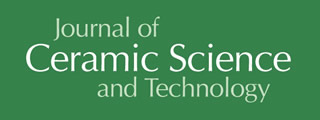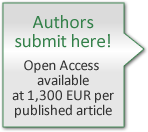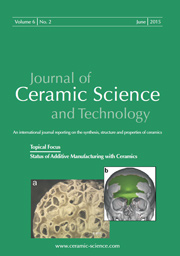Articles
All articles | Recent articles
Thermal Shock and Thermo-Mechanical Behavior of Carbon-Reduced and Carbon-Free Refractories
A. Böhm1, S. Dudczig2, J. Fruhstorfer2, A. Mertke2, C.G. Aneziris2, J. Malzbender1
1 Forschungszentrum Jülich GmbH, Institute of Energy and Climate Research, IEK - 2, Wilhelm-Johnen-Strasse, D-52425 Jülich, Germany
2 TU Bergakademie Freiberg, Institute of Ceramic, Glass and Construction Materials, Agricolastraße 17, D-09596 Freiberg, Germany
received December 4, 2015, received in revised form February 1, 2016, accepted February 20, 2016
Vol. 7, No. 2, Pages 155-164 DOI: 10.4416/JCST2015-00081
Abstract
The thermal shock behaviour of novel carbon-reduced refractories with maximum grain size of 1 mm was investigated. A wedge splitting test for small specimen geometries (max. 40 × 40 × 20 mm3) was successfully implemented with different loading configurations to determine "work of fracture" and thermal shock parameters. Additionally, heating-up thermal shock tests were performed with an electron beam facility. The addition of 2.5 wt% ZrO2 and TiO2 to Al2O3 refractories appears to improve their thermal shock resistance due to microstructural changes that reduce brittleness and inhibit critical crack growth. However, a phase transition of ZrO2 affects the properties at elevated temperature. For another pure alumina refractory, no geometry-independent value for the work of fracture could be obtained for the sample geometry used, which is probably related to the formation of a large interaction zone of the fracture surfaces. Al2O3-C materials with addition of semi-conductive Si and nanoparticles revealed a strong effect of the pressing direction on the work of fracture. However, the thermal shock parameter R'''' was hardly affected by the different additives. Furthermore, thermal shock tests using the electron beam facility JUDITH 1 did not indicate any significant differences in the damage pattern of the different Al2O3-C materials.
![]() Download Full Article (PDF)
Download Full Article (PDF)
Keywords
Ceramics, refractories, thermal shock, wedge splitting test, electron beam
References
1 Lee, W.E., Moore, R.E.: Evolution of in situ refractories in the 20th century, J. Am. Ceram. Soc., 81, [6], 1385 – 1410, (1998).
2 Harmuth, H.: Fracture mechanics characterization of heavy clay refractory materials – importance, procedure and application, (in German), Ber. Dt. Keram. Ges., 10, [3], 27 – 61, (1994).
3 Hasselman, D.P.H.: Unified theory of thermal shock fracture initiation and crack propagation in brittle ceramics, J. Am. Ceram. Soc., 52, [11], 600 – 604, (1969).
4 Hasselman, D.P.H.: Thermal stress resistance parameters for brittle refractory ceramics – a compendium, Am. Ceram. Soc. Bull., 49, [12], 1033 – 1037, (1970).
5 Tschegg, E.K., Linsbauer, H.: Test set-up for determination of fracture mechanics characteristics as well as test specimens suitable for this, (in German), Austrian Patent, (1989).
6 Tschegg, E.K.: New equipment for fracture tests on concrete, Materialprüfung, 33, [11 – 12], 338 – 343, (1991).
7 Harmuth, H., Tschegg, E.K.: A fracture mechanics approach for the development of refractory materials with reduced brittleness, Fatigue Fract. Eng. M., 20, [11], 1585 – 1603, (1997).
8 Ribeiro, S., Rodrigues, J.: The influence of microstructure on the maximum load and fracture energy of refractory castables, Ceram. Int., 36, [19], 263 – 274, (2010).
9 Kim, J.K., Kim, Y.Y.: Fatigue crack growth of high-strength concrete in wedge-splitting test, Cement Concrete Res., 29, [5], 705 – 712 (1999).
10 DIN EN 820 – 3: Advanced technical ceramics – methods of testing monolithic ceramics – thermomechanical properties – Part 3: determination of resistance to thermal shock by water quenching, 2004.
11 Linke, J., Bolt, H., Doerner, R., Grübmeier, H., Hirooka, Y., Hoven, H., Mingam, C.: Performance of boron/carbon first wall materials under fusion relevant conditions, J. Nucl. Mater., 176, 856 – 863, (1990).
12 Hirai, T., Kreter, A., Linke, J., Malzbender, J., Ohgo, T., Philipps, V., Pintsuk, G., Pospieszczyk, A., Sakawa, Y., Sergienko, G., Tanabe, T., Ueda, Y., Wada, M.: Critical heat flux loading experiments on CVD-W coating in the TEXTOR tokamak, Fusion Eng. Des., 81, 175 – 180, (2006).
13 Skiera, E., Thomser, C., Linke, J., Roungos, V., Aneziris, C.G.: Thermal shock testing of different carbon bonded MgO-C materials by application of an electron beam test facility, Refractories Worldforum, 4, [1], 125 – 129, (2012).
14 Aneziris, C.G., Dudczig, S., Gerlach, N., Berek, H., Veres, D.: Thermal shock performance of fine-grained Al2O3 ceramics with TiO2 and ZrO2 additions for refractory applications, Adv. Eng. Mater., 12, [6], 478 – 485, (2010).
15 Aneziris, C.G., Pfaff, E., Maier, H.: Ceramic materials in the system ZrO2-TiO2-Al2O3 for applications in the ferrous and non ferrous metallurgy, Key Eng. Mater., 132, 1829 – 1833, (1997).
16 Aneziris, C., Schärfl, W., Ullrich, B.: Microstructure evaluation of Al2O3 ceramics with Mg-PSZ- and TiO2-additions, J. Eur. Ceram. Soc., 27, [10], 3191 – 3199, (2007).
17 Stein, V., Aneziris, C.: Low-carbon carbon-bonded alumina refractories for functional components in steel technology, J. Ceram. Sci. Tech., 5, [2], 115 – 124, (2014).
18 Aneziris, C.G., Klippel, U., Schärfl, W., Stein, V., Li, Y.: Functional refractory material design for advanced thermal shock performance due to titania additions, Int. J. Appl. Ceram. Tec., 4, [6], 481 – 489, (2007).
19 Roungos, V., Aneziris, C., Berek, H., Skiera, E., Thomser, C.: Advances of nanoscaled additives on the thermo-mechanical performance of Al2O3-C and MgO-C refractories, Refractories Worldforum, 4, [1], 91 – 104, (2012).
20 Skiera, E., Malzbender, J., Mönch, J., Dudczig, S., Aneziris, C.G., Steinbrech, R.W.: Controlled crack propagation experiments with a novel alumina-based refractory, Adv. Eng. Mater., 14, [4], 248 – 254, (2012).
21 Böhm, A., Fruhstorfer, J., Mertke, A., Aneziris, C.G., Malzbender, J.: Thermal shock behavior of carbon reduced refractories. in: proceedings of the unified international technical conference on refractories. Victoria, Canada, 2015.
22 Mertke, A., Aneziris, C.: The influence of nanoparticles and functional metallic additions on the thermal shock resistance of carbon bonded alumina refractories, Ceram. Int., 41, [1], 1541 – 1552, (2015).
23 Böhm, A.: Thermal shock behavior and temperature-dependent properties of carbon-reduced and carbon-free refractory materials, Ph.D. thesis, RWTH Aachen, (2015).
24 DIN 51045: Determination of linear thermal expansion of solids, 2005.
25 Wei, J., Pecanac, G., Malzbender, J.: Review of mechanical characterization methods for ceramics used in energy technologies, Ceramic Int., 40, [10], 15371 – 15380 (2014).
26 Malzbender, J., Steinbrech, R.W., Singheiser, L.: A review of advanced techniques for characterising behaviour, Fuel Cells, 9, [6], 785 – 793, (2009).
27 ASTM E 1876 – 01: Standard test method for dynamic young's modulus, shear modulus, and poisson's ratio by impulse excitation of vibration, 2005.
28 Skiera, E.: Thermomechanical characterization of newly developed refractory materials, Ph.D. thesis, RWTH Aachen, (2012).
29 Aneziris, C., Schär, W., Ullrich, B.: Microstructure evaluation of Al2O3 ceramics with Mg- PSZ- and TiO2-additions, J. Eur. Ceram. Soc., 27, [10], 3191 – 3199, (2007).
30 Aneziris, C.G., Dudczig, S., Gerlach, N., Berek, H., Veres, D.: Thermal shock performance of fine-grained Al2O3 ceramics with TiO2 and ZrO2 additions for refractory applications, Adv. Eng. Mater., 12, [6], 478 – 485, (2010).
31 Fruhstorfer, J., Möhmel, S., Thalheim, M., Schmidt, G., Aneziris, C.G.: Microstructure and strength of fused high alumina materials with 2.5 wt% zirconia and 2.5 wt% titania additions for refractory applications, Ceram. Int., 41, [9], 10644 – 10653, (2015).
32 Michalowsky, L., Hermann, M.: New ceramic materials, (in German), Wiley Online Library, (1994).
33 Pandolfelli, V., Rodrigues, J., Stevens, R.: Effects of TiO2 addition on the sintering of ZrO2 – TiO2 compositions and on the retention of the tetragonal phase of zirconia at room temperature, J. Mater. Sci., 26, 5327 – 5334, (1991).
34 Gault, C., Platon, F. and Bras, D.L.: Ultrasonic measurements of Young's modulus of Al2O3-based refractories at high temperatures, Mater. Sci. Eng., 74, [1], 105 – 111, (1985).
35 Traon, N., Etzold, S., Tonnesen, T., Telle, R.: Influence of zirconia doping agent on the fatigue of high alumina refractory castables at elevated temperatures, In: Proceedings of the Unified International Technical Conference on Refractories. Victoria, Canada, 2015.
36 Joliff, Y., Absi, J., Huger, M., Glandus J.C.: Experimental and numerical study of the elastic modulus vs. temperature of debonded model materials, Comp. Mater. Sci., 44, [2], 826 – 831, (2008).
37 Kuchling, H.: Physics Pocket Book, (in German), 20th Edition, München, Fachbuchverlag Leipzig, (2011).
Copyright
Göller Verlag GmbH


